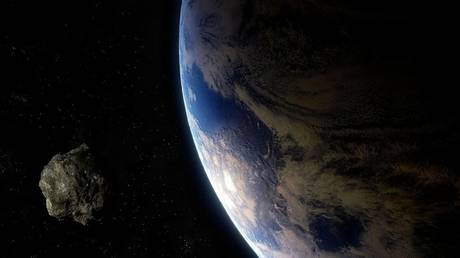
NASA is warning of the second ‘stadium-sized’ asteroid headed towards the Earth in as many weeks, shortly after announcing the postponement of its critical planetary defense mission to 2022.
On February 27, the asteroid 2021 DE, with a diameter roughly the same size as the Arc de Triomphe (49m), will buzz the Earth at a distance of 1.6 million kilometers (mn km), followed shortly afterwards on February 28 by the 20-meter 2021 DM at a distance of 4.8 mn km.
Upping the ante significantly the following day, March 1, will be the Statue of Liberty-sized (91m) space rock 2011 DW, which will shoot past at a distance of 5.3 mn km.
Then on March 2 comes the piece de resistance, the second asteroid in two weeks which NASA describes as ‘stadium-size’: 1999 RM45, with a diameter of 396m – roughly 1.1 times the height of the Empire State building, 1.75 times that of the Golden Gate Bridge, or 0.5 times the size of the Burj Khalifa – will pay the Earth a passing visit at a safe distance of 2.6 mn km.
None of the aforementioned asteroids pose a particular threat to the planet, according to current understanding of their trajectories, but increasing reports about stadium-sized asteroids entering the Earth’s vicinity merely heighten fears of a potential impact.
The US space agency announced that its long-anticipated Double Asteroid Redirection Test (DART) planetary defense mission is now scheduled to launch in 2022, given that this year’s primary launch window from July 21 to August 24 is no longer viable.
According to a NASA statement, the mission was postponed due to technical issues with two major components of the spacecraft, as well as supply chain issues caused partly by the global Covid-19 pandemic.
Alas, one of the Earth’s most proactive missions to tackle the ever-present danger of asteroid annihilation will now take place some time during its backup window, which opens on November 24 and runs to February 15, 2022.
“At NASA, mission success and safety are of the utmost importance, and after a careful risk assessment, it became clear DART could not feasibly and safely launch within the primary launch window,” NASA Science Mission Directorate Associate Administrator Thomas Zurbuchen said in a statement.
The DART spacecraft should eventually launch on board a SpaceX Falcon 9 rocket from a US Air Force base in California. Its target is a binary asteroid system consisting of the 775-meter wide Didymos and 165-meter Dimorphos.
The DART mission is aiming to slam into Dimorphos and knock it off course, thereby proving the viability of deflecting asteroids as a primary planetary defense technique.
Think your friends would be interested? Share this story!




